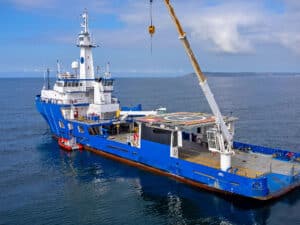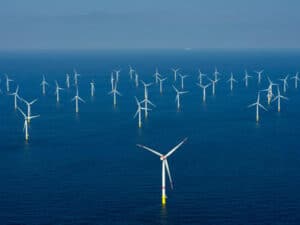
New GE podded drive uses pump jet technology
Written by Nick Blenkey MAY 6, 2013 — GE’s Power Conversion business (NYSE: GE) has increased its offshore systems portfolio with Inovelis, a podded thruster aimed at the platform supply vessel market that uses pump jet technology.
MAY 6, 2013 — GE’s Power Conversion business (NYSE: GE) has increased its offshore systems portfolio with Inovelis, a podded thruster aimed at the platform supply vessel market that uses pump jet technology.
Inovelis incorporates an electrically powered propeller with its motor housed within a steerable pod mounted beneath the hull of an offshore vessel. It incorporates all the assets of a podded thruster, including maneuverability, responsiveness and excellent fuel economy.
Based on pump jet principles, it features fixed stator vanes and a nozzle that act together to guide the water flow across the impeller blades, substantially enhancing propulsion efficiency. Its compactness enables an even greater degree of integration between the hull and the propulsion unit, further influencing the ships’ fuel economy and emissions.
Pump jet technology was originally used in submarines and is already used for high-speed surface vessels. Now GE is applying it to offshore platform support vessels (PSVs).
GE says that the Inovelis solution has higher thrust capability than a more conventional propulsion system, as well as improved hydrodynamics, providing higher efficiency over a wider range of operations, in dynamic positioning (DP) and in transit. A traditional propulsion setup for a PSV has a large propeller with a nozzle, which has reduced performance when the speed of the ship increases.
Whereas a vessel with a traditional propulsion system has a propeller pushing on the water, a pump jet draws in water and then forcibly ejects it out through a nozzle. It is the marine equivalent of a jet engine, except that while jet engines are fixed, Inovelis can be pointed in any direction on a horizontal plane.
“Inovelis is a new concept that brings better performance—both improved thrust capability as well as improved hydrodynamics—combined maximize performance of pod technology and will bring fuel efficiency,” says Paul English, marine leader of GE Power Conversion.
He cites a PSV driven by two 2.5-megawatt Inovelis pods, operating 30 percent of the time in transit at full speed. “The benefit in terms of fuel savings could be, based on our estimates, up to $250,000 in one year,” says Mr. English.
“There is a clear trend towards larger, more capable offshore support vessels and a second trend towards the search for oil and gas taking these vessels ever further from home ports,” says Mr. English. “Ship operators are looking for systems that support cost-effective, fuel-efficient, rapid transit without sacrificing the capability to operate effectively and efficiently once on site in DP mode. This raises a dilemma as many current designs are a compromise between these two differing requirements.”
Mr. English says that the Inovelis advantage is so significant that it has the potential to permit ship designers to incorporate reduced capacity power plant—fewer cylinders or smaller engines—when designing offshore vessels.
Inovelis uses GE’s innovative induction motor technology, which brings further reliability and helps reduce maintenance requirements. In fact, the pod has a “no man access” design, which helps reduce overall size and provides an additional differentiation from other designs.
“When the combination of engines, electrical power plant, Inovelis thruster and control systems such as DP are correctly designed and optimized as a system, there can be massive advantages in terms of initial cost and lifetime cost,” says Mr. English. “Great components become great systems, and the benefits endure for the lifetime of the ship.”
GE already has received a number of Inovelis orders, all destined for large PSVs. These include eight being built for Swire Pacific for which GE is supplying integrated power generation, propulsion, dynamic positioning (DP) and automation.
Four of the Swire Pacific PSVs are being built by Universal Shipbuilding Corporation (USC) in Japan and the remaining four by the Estaleiro Ilha S.A. (EISA) shipyard in Brazil.





Leave a Reply
You must be logged in to post a comment.